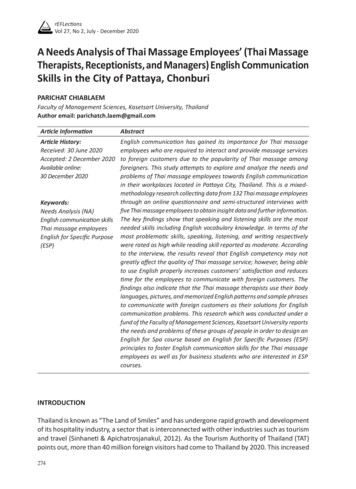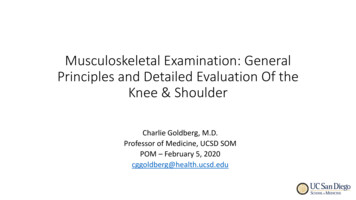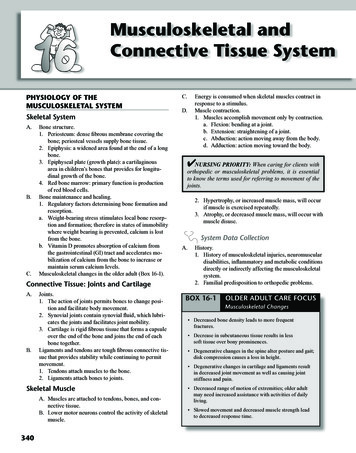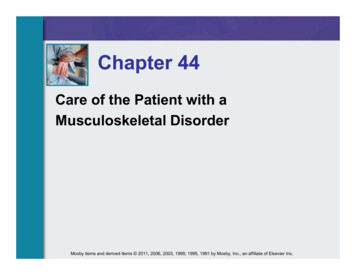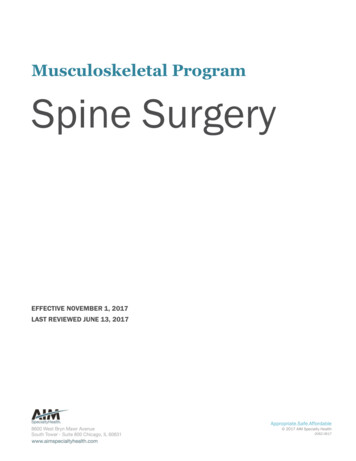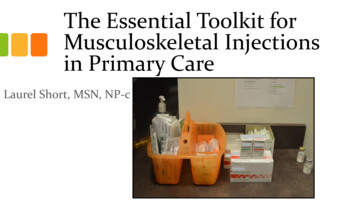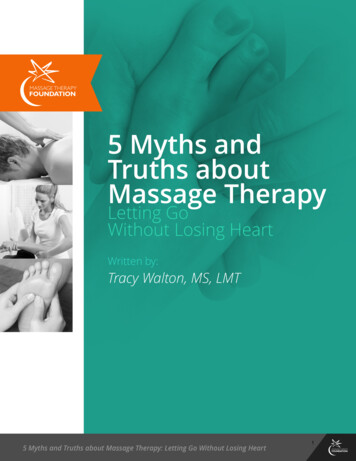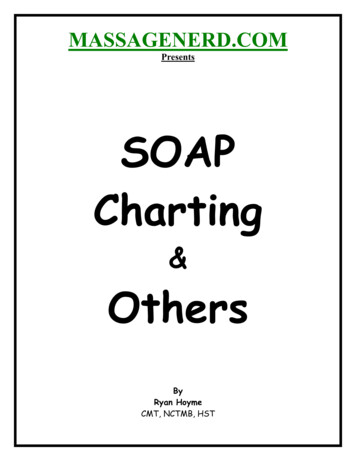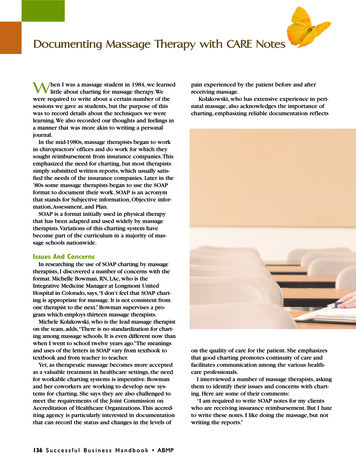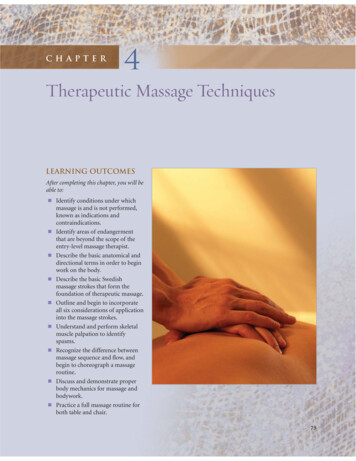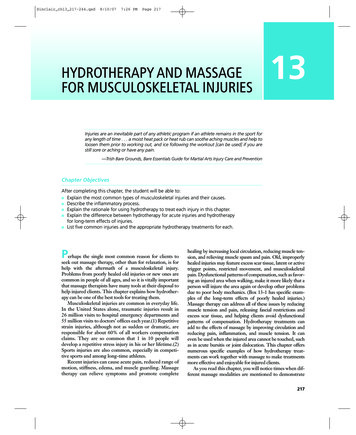
Transcription
Sinclair ch13 217-244.qxd8/10/077:26 PMPage 217HYDROTHERAPY AND MASSAGEFOR MUSCULOSKELETAL INJURIES13Injuries are an inevitable part of any athletic program if an athlete remains in the sport forany length of time . . . a moist heat pack or heat rub can soothe aching muscles and help toloosen them prior to working out, and ice following the workout [can be used] if you arestill sore or aching or have any pain.—Trish Bare Grounds, Bare Essentials Guide for Martial Arts Injury Care and PreventionChapter ObjectivesAfter completing this chapter, the student will be able to: Explain the most common types of musculoskeletal injuries and their causes. Describe the inflammatory process. Explain the rationale for using hydrotherapy to treat each injury in this chapter. Explain the difference between hydrotherapy for acute injuries and hydrotherapyfor long-term effects of injuries. List five common injuries and the appropriate hydrotherapy treatments for each.Perhaps the single most common reason for clients toseek out massage therapy, other than for relaxation, is forhelp with the aftermath of a musculoskeletal injury.Problems from poorly healed old injuries or new ones arecommon in people of all ages, and so it is vitally importantthat massage therapists have many tools at their disposal tohelp injured clients. This chapter explains how hydrotherapy can be one of the best tools for treating them.Musculoskeletal injuries are common in everyday life.In the United States alone, traumatic injuries result in26 million visits to hospital emergency departments and55 million visits to doctors’ offices each year.(1) Repetitivestrain injuries, although not as sudden or dramatic, areresponsible for about 60% of all workers compensationclaims. They are so common that 1 in 10 people willdevelop a repetitive stress injury in his or her lifetime.(2)Sports injuries are also common, especially in competitive sports and among long-time athletes.Recent injuries can cause acute pain, reduced range ofmotion, stiffness, edema, and muscle guarding. Massagetherapy can relieve symptoms and promote completehealing by increasing local circulation, reducing muscle tension, and relieving muscle spasm and pain. Old, improperlyhealed injuries may feature excess scar tissue, latent or activetrigger points, restricted movement, and musculoskeletalpain. Dysfunctional patterns of compensation, such as favoring an injured area when walking, make it more likely that aperson will injure the area again or develop other problemsdue to poor body mechanics. (Box 13-1 has specific examples of the long-term effects of poorly healed injuries.)Massage therapy can address all of these issues by reducingmuscle tension and pain, releasing fascial restrictions andexcess scar tissue, and helping clients avoid dysfunctionalpatterns of compensation. Hydrotherapy treatments canadd to the effects of massage by improving circulation andreducing pain, inflammation, and muscle tension. It caneven be used when the injured area cannot be touched, suchas in acute bursitis or joint dislocation. This chapter offersnumerous specific examples of how hydrotherapy treatments can work together with massage to make treatmentsmore effective and enjoyable for injured clients.As you read this chapter, you will notice times when different massage modalities are mentioned to demonstrate217
Sinclair ch13 217-244.qxd2188/10/077:26 PMPage 218MODERN HYDROTHERAPY FOR THE MASSAGE THERAPISTBOX 13-1Point of InterestPOORLY HEALED INJURIES CAN HAVE LONG-TERM EFFECTS ON THE BODYTraumatic injuries that are not properly healed can cause longterm effects on the body. Below are some examples, each ofwhich highlights the importance of proper healing to preventfuture problems. Leg length inequality—the condition in which one leg isshorter than the other—can cause an uneven gait, a limp, hipand knee pain, and chronic low back problems. It can alsolead to osteoarthritis both in the spine and in the hip of thelonger leg. Poorly healed injuries can cause this condition inmore than one way. For example, a femur fracture that healspoorly can cause one leg to be structurally shorter than theother one. However, leg length inequality can also be functional, that is, not caused by a structural problem. Instead,injuries can lead to soft tissue tightness that causes one leg tobe held in such a way that is functionally shorter. For example,trigger points in the quadratus lumborum are often activatedby trauma from motor vehicle accidents. When there areactive, untreated trigger points in one quadratus lumborummuscle, that hip can be pulled up, secondary trigger pointscan occur in nearby muscles, lumbar scoliosis ensues, and thenormal lumbar curve is flattened. Over time, the changeswhich begin in the injured muscle cause long-term problemsin alignment, accompanied by uneven wear and tear on jointsand musculoskeletal pain.At 8 years of age, massage therapist Genie Martin fell 20feet out of a tree, striking branches on the way down andhitting her head hard enough to be knocked unconscious.Although Martin suffered only soft-tissue damage, shestopped breathing and lost consciousness, and she had tobe given artificial respiration. Once she was breathing again,she was taken home. As she tells it, “My life was given backto me, though I was not aware of it for many hours. Andwhen I did become aware of it, I no longer wanted it. Pain,heretofore unknown to me except for little hurts, was nowmy constant companion. A more nagging, convulsive, ruthless and demanding companion I had never known about inall my small life. Pain kept me awake at night—made myhead ache with every move—burned my chest with fire, sothe pairing of hydrotherapy and massage, but these arenot guidelines for what type of massage techniques to use.Specific massage techniques, including stretching andrange-of-motion exercises used for injuries, are outsidethe scope of this book.TYPES OF INJURIESBefore we turn to actual hydrotherapy treatments, firstwe discuss the three types of musculoskeletal injuries.TRAUMATIC INJURYPhysical trauma to the body can cause a variety of injuries,including skin wounds, muscle strains, fractures, sprains,dislocations, tears in cartilage or ligaments, contusions, much that I squeezed my arms tightly around to smother theflames.” From that time on, Martin carried a great deal oftension in her chest and experienced chest pain when shewas anxious. Many negative emotions were carried in herchest, including a fear of falling, a fear of trying new things,and a fear of recurring pain. As an adult, Martin slept withher arms so tightly gripped over her chest that sometimeswhen she awoke they were numb. While receiving massages, she had to make a tremendous effort to stop herarms from springing over her chest to protect it. It was notuntil she was attending massage school as a middle-agedwoman and receiving massage therapy that she began toheal from the emotional and physical effects of the injury.Football great Joe Namath was injured numerous times in hiscareer—bruises, torn muscles, dislocations, sprains, torn cartilage and ligaments, fractures, and concussions. Namath frequently played even when he had new, unhealed injuries. Thisnot only increased the chances of making the original injuriesworse but also made it more likely that another area close bywould be injured as well, because favoring an injured areacauses other anatomical structures around it to be underincreased stress. Namath began to have severe, ongoing kneepain as early as age 20, developed bursitis and severe swellingin both knees by age 24, and underwent many surgeries onhis knees in an attempt to repair damage to tendons, cartilage, ligaments, and bursae. Although his physical problemsforced him to retire at age 34, he continued to pay the pricefor playing with poorly healed injuries. At age 37 he hadsevere osteoarthritis in his fingers and spine, and at age 47had joint replacement surgery on both knees. Unfortunately,knee replacement surgery was not able to eliminate his painand even standing is painful for him now.References:1. Krieger M. Namath: A Biography. New York: Viking, 2004.2. Martin G. Trauma and recall in massage: A personal experience.Massage Therap J Winter 1985, p 35.3. Travell J, Simons D. Myofascial Pain and Dysfunction: The TriggerpointManual, vol 2, 2nd ed. Baltimore: Williams & Wilkins, 1999, p 49.back injuries, and even amputations. These injuries cause27% of all visits to hospital emergency departments.Motor vehicle accidents and falls are the two most common traumatic injuries. Bicycle accidents, assaults, fires,recreational accidents, domestic violence, child abuse, suicides, homicides, and accidents while operating machinery are other significant causes of injury. On the job,traumatic injuries can include sprains, strains, muscletears, fractures, and back injuries.SPORTS INJURYSports injuries may be acute, such as a muscle strain, fracture, or dislocation which occurs while playing a sport.However, they can also be chronic, such as inflammatoryconditions from overuse. Muscle injuries can result frompoor conditioning, muscular imbalance, excessive muscle
Sinclair ch13 217-244.qxd8/10/077:26 PMPage 219CHAPTER 13BOX 13-2 Hydrotherapy and Massage for Musculoskeletal Injuries219Point of InterestHYDROTHERAPY AND MASSAGE USED IN INTENSIVE TREATMENT OF AN ATHLETIC INJURYThe following excerpt from the Columbia [Missouri] Daily Tribune,while it does not involve a massage therapist, illustrates theeffectiveness of hydrotherapy for treating sports injuries.When Corby Jones suffered a significant toe sprain inUniversity of Missouri’s football game against Northwesternon October 3, 1998, the clock began ticking for the Missourisports medicine staff. The staff had seven days to improveJones’s condition and keep him in football-playing shape sothat he could take the field next Saturday at Iowa State. AsJones’ toe became the favorite topic of sports pages aroundthe state, Rex Sharp, MU’s head athletic trainer, knew thepressure was on his staff to heal the ailing digit. “It was probably the most well-publicized toe injury I’d ever seen,” Sharpsays. Monday, Tuesday and Wednesday, Jones spent themajority of his time in the Dr. Glenn L. McElroy Medicine andRehabilitation Center, the new MU sports medicine facilitythat had opened late in the summer. Sharp treated Jones fortension, or inadequate healing of a previous injury. Themost common sports injuries are muscle strains, tendonitis,and joint sprains. (As shown in Box 13-2, hydrotherapytechniques can accelerate healing of injuries.)REPETITIVE STRESS INJURYRepetitive stress injuries are caused by the physical strain ofperforming the same movements for many hours, particularly if the person is in an awkward position or having to usegreat force to perform the task. Any repetitive activity—fromtyping to heavy lifting—can initiate an injury in a particularpart of the body. Common injuries include tendonitis, bursitis, carpal tunnel syndrome, and disc herniation.HYDROTHERAPY AND INJURIESMassage therapists do not treat or evaluate injuries whenthey occur. When clients are injured, it is important thatthey consult with their doctor, go to the hospital, or evencall 911 to ensure that their injuries are properly diagnosedand treated. Then, as long as the doctor has approved massage, clients may be treated whether their injury is acute(sudden onset and not prolonged), subacute (less than completely acute, between acute and chronic), or chronic (lasting 3 months or more and showing virtually no change).HYDROTHERAPY AND PAINFROM INJURIESWhen a musculoskeletal structure is injured, nociceptors,receptors on the skin or in deeper structures that carry painsignals to the brain, are stimulated. This pain helps alert us10 hours a day—heating the injury in the whirlpool, runninghim in the Swim Ex pool [rehabilitation pool with a currentthat the athlete can swim against], having him ride the stationary bikes and exercise on the stair stepper. Sharp coatedJones’ toe in a paraffin bath and treated the toe with ultrasound and massages. However, when Friday came, and theteam made the trip to Iowa State, Sharp was still unsure ofsuccess. “We did everything we could, but on Friday I still didnot know whether he’d be able to play,” Sharp said. The linefor Jones on Saturday in an MU win—9 for 15 passing for176 yards and two touchdowns, along with one rushingtouchdown.“When people come to a football game, all theysee are the players running out on the field,” Sharp said.“Then they go home. They have no idea of what goes on allweek long.”—Luke Vilelle, Heal Thyself With Help. Columbia DailyTribune, June 16, 1999to threats against our body and also promotes healing byforcing us to rest. Pain gets our attention! When it is properly used, hydrotherapy can promote healing and alleviatemuch of the short-term discomfort and pain of recent musculoskeletal injuries. According to Agatha Thrash, MD,who has 40 years of experience in this area, “The application of heat or cold to relieve the pain of acute or chronicinflammatory disorders has been used for centuries, and isstill a method without peer in the area of pain control. Noother method is so effective, so safe and easy, and so freefrom side effects and expense.”(3) Muscle spasm and painare common after both acute and subacute injuries, and forthose who cannot take medications such as pain relieversor antispasmodics, hot and cold treatments can offer greatrelief. Heat relaxes muscles and slows conduction of painmessages to the brain. In one study, researchers found thatlocal heat applied over the palm could even relieve the painof a mild electric shock.(4) Recent research with heat wrapsworn continuously for hours has found that they canrelieve both neck and low back pain better than ibuprofenor acetaminophen.(5) Cold applications, on the otherhand, numb muscles and also relieve pain by overriding orbypassing pain messages to the brain. Contrast treatments,however, appear to relieve pain by greatly increasing localcirculation.Hydrotherapy can also help prevent long-term tissuedysfunction by promoting proper healing. Treating thelong-term consequences of various musculoskeletal traumas often requires myofascial work or breaking up of oldadhesions, and heat can relax and warm soft tissues, making deep work much easier. Heating treatments such asparaffin or moist hot packs can help soften old scar tissueso that massage techniques are less painful and moreeffective.
Sinclair ch13 217-244.qxd8/10/077:26 PMPage 220HYDROTHERAPY AND INFLAMMATIONAs shown in Figure 13-1, injuries are almost alwaysaccompanied by inflammation. Because massage therapists perform massage with many clients with both recentand old injuries, it is important for them to understandthis process. (Box 13-3 has more about the stages ofinflammation.) To reduce inflammation, musculoskeletaltrauma is generally treated with cold applications for thefirst 48 hours after an injury. Cold causes local blood vessels to constrict, which reduces bleeding from any bloodvessels that are still not sealed off. It also reduces inflammation. However, after 48 hours, the application of coldpacks and ice packs will continue to inhibit the circulation, thereby decreasing arterial blood flow, soft tissueblood flow, and local metabolism. After that point, contrast, not cold, applications are recommended, becausethey not only increase circulation to specific areas andease pain, they also keep edema at bay. Various antiinflammatory medications may be used at this stage of aninjury, but because much research indicates that they canactually delay or inhibit healing, contrast treatments thatstimulate blood flow and bring extra oxygen and othernutrients to the injured tissues are generally preferred.(6)After the first 48 hours, a contrast treatment followed bylymphatic drainage techniques can be used in the earlierstages of an injury, while contrast treatments may becombined with circulatory massage and other techniquesin the later stages of an injury.A very important benefit of early treatment withhydrotherapy and massage is the healing an injury withappropriate scar tissue. In the subacute phase of an injury,cells which produce collagen fibers form scar tissue aroundthe injury to knit the damaged area back together. Initially,BOX 13-3HematomaTenoblasts CapillariesParatenonSynovial fluidEpitenonASEVERED Non organized collagenBREPAIRING TENDONOrientated collagenCHEALED TENDONFIGURE 13-1 Tendon healing. A. Acute phase of repair of a torntendon. B. Subacute phase of repair of a torn tendon. C. Healed tendon. (Reprinted with permission from Bucholz RW, Heckman JD.Rockwood and Greens Fractures in Adults. 5th ed. Baltimore: LippincottWilliams & Wilkins, 2001.)Point of InterestTHE BODY HEALS THROUGH INFLAMMATIONInflammation is the body’s defensive response to injury. The fourmain signs are redness, swelling, heat, and pain. Let’s considerwhat happens when the body sustains an injury in which a lot offorce is applied to an area, such as a shoulder dislocation. At themoment of injury, not only are blood vessels and nerves torn, butmuscle and connective tissue cells may be ripped open. As seenin Figure 13-1A, the body responds to the injury with many protective responses, including the following:Initially, local blood vessels constrict to prevent blood loss.Soon afterward, many more local capillaries than usual dilate,and as they open wide the area is flooded with fresh blood.Fibrin and blood platelets collect in the blood vessels at the siteof the injury and gradually close off the damaged vessels. (Heatapplied to the area in the very early stages after an injury, beforethe small capillaries are closed off, increases the chance that theywill leak blood and plasma into the soft tissues around the injury.Heat should not be applied until the capillaries have been sealedand have stopped leaking, which usually requires a maximum of24 hours except in the case of very severe injuries.)Because there is a sharp increase in the number of active capillaries, a significant increase in their diameter, and blood leaking220out of broken vessels and pooling, blood flow to the areaincreases. However, with many vessels wide open, the bloodactually flows more slowly, and this allows more macrophagesto get into the area. Their job is to remove damaged tissue. Moreheat-carrying blood that is flowing more slowly creates some ofthe cardinal signs of inflammation—redness and heat, swellingbecause there is more fluid in the area, and pain because extrafluid puts pressure on nerve endings. If there is enough inflammation to limit movement, loss of function, the fifth sign of inflammation, can result.Leukocytes concentrate where the tissue damage is the greatest, engulfing and destroying the tissue debris that was createdby the rupture of individual cells, along with any pathogens thatare present. At the same time, if there is any bleeding, this debrisand a mass of red blood cells form a hematoma, a local mass ofblood. Pressure on pain nerves causes additional pain.In the subacute phase, as seen in Figure 13-1B, tissues are beginning to heal; ruptured small blood vessels have closed, white bloodcells are cleaning up debris, blood flow has returned to its normalstate, and cells which produce collagen fibers are forming scar tissue around the injury to knit the damaged area back together.
Sinclair ch13 217-244.qxd8/10/077:26 PMPage 221CHAPTER 13new collagen fibers form without having any direction orgrain (Fig. 13-2A), and without proper treatment, theymay either form in the wrong direction or attach to thestructures that they should be gliding over. If not alignedwith the other tissues, they can adhere to structures such asfascia or muscle, and then they have a restricting, not reinforcing, effect. These scar tissue fibers are not as elastic asmuscle fibers, and they have a tendency to restrict freemovement and to tear when they are exposed to stress.Many chronic musculoskeletal problems can result fromexcessive or poorly aligned scar tissue. Massage treatmentof many subacute injuries focuses on helping the area healwithout this type of scar tissue. Exercise is important at thisstage, for the injured part will heal best when the personmoves it actively but gently, allowing it to remain pliableand healthy, and ensuring that scar tissue fibers are properly aligned (Fig. 13-2B). Once pain relief is achieved withcontrast treatments and massage, gentle exercise promotesthis optimum healing. Exercising while the part is in a contrast bath increases local circulation even more.A traditional adjunct to hydrotherapy for injuries is theuse of herbal preparations: as explained in Box 13-4, herbshave been used for centuries to treat muscle soreness andA Hydrotherapy and Massage for Musculoskeletal Injuries221aching, inflammation, muscle spasm, poor local circulation, and poorly healing wounds.AMPUTATIONAn amputation is the cutting off of a limb or a part of alimb. It is performed when it would be dangerous to leavethat part of the body because of life-threatening infection, irreversible damage to local blood vessels, tissuedamage beyond the hope of repair, or advanced loss offunction. As a result of increasing rates of diabetes in theUnited States, amputations are an injury you are likely toencounter among your clients. As of 2007, 20 millionAmericans had diabetes, and of the 82,000 amputationsperformed in the United States each year, 70% are due todiabetes. Most of the rest are the result of musculoskeletal trauma or cancer.(7,8) Accidents such as injuries fromlawnmowers or gunshot wounds cause most amputationsin children, whereas diseases cause most of them inadults. Individuals with advanced diabetes have to haveamputations when sores on their feet will not heal.Gangrene in the foot that spreads to the rest of the person’s body can be fatal, so instead the foot is sacrificed.Hydrotherapy can be a helpful treatment for clientswith amputated limbs, in particular when the amputationstump is sensitive to touch or local circulation is poor.Hydrotherapy is an excellent way to improve the client’stolerance for tactile stimulation, improve circulation to thestump, soften adhesions, and begin the massage experiencein a soothing fashion. Warm-water whirlpools, for example, are sometimes used by physical therapists to desensitize amputation stumps, increase local circulation, andpossibly relieve phantom pain. Besides helping the amputation stump itself, using hydrotherapy treatments such asmoist hot pack applications can help relieve discomfort andtension in muscles in other parts of the body, such as theback or extremity, which are compensating for the missingpart. For example, with one leg amputated above the knee,compensations may cause muscle tightening and discomfort at the hip directly above the stump, in the entire otherleg, and/or in the back.TREATMENTBelow are two hydrotherapy treatments that are usefulfor treating clients with amputations.CONTRAST TREATMENTOF THE STUMPBFIGURE 13-2 Ligament fiber organization. A. Incompletely healed ligament with disorganized fibers. B. Fully healed ligament with well organizedfibers. (Reprinted with permission from Archer M. Therapeutic Massage inAthletics. Baltimore: Lippincott Williams & Wilkins, 2004: 104, Fig. 6-4.)The contrast treatment may be extended to the entireextremity by using more than one hot pack or heatingpad. A moist hot pack can be applied by itself but willnot stimulate the circulation as much as a contrasttreatment.(Continued)
Sinclair ch13 217-244.qxd222BOX 13-48/10/077:26 PMPage 222MODERN HYDROTHERAPY FOR THE MASSAGE THERAPISTPoint of InterestHERBS TRADITIONALLY USED WITH HYDROTHERAPY TO TREAT INJURIEStrauma. Massage therapists who use herbal preparations in theirclients’ hot and cold compresses, local baths, fomentations, icemassage plasters, and other water treatments feel that it deepens the effectiveness of hands-on techniques.Herbal preparations have been used for centuries along withhydrotherapy treatments for many injury-related problems.These include soreness; aching and inflammation; musclespasms; poor local circulation; and wounds caused by physicalHERBS FOR MUSCLE SORENESS, ACHING, AND INFLAMMATIONHerbArnicaCalendulaChamomileComfreySt. John’s wortWitch hazelBruise XXXXHERBS FOR MUSCLE SPASMS AND MUSCLE TIGHTNESSMuscleCrampsHerbBlackhawChamomileCramp barkGingerLavenderLobeliaMulleinFluAchesand PainsXXXXSleepAid S WHICH TREAT INJURIES BY IMPROVING LOCAL ibrositisFracture(delayed Frozenunion) orCirculationXXXHERBS FOR WOUNDSHerbArnicaComfreySt. John’s wortDelayedUnion ofFracturesDamagedJoints andMusclesXXXXPulledTendonsXReferences1. Treasure J. MNIMH, AHG, Course notes from class “Herbs and Massage,” Eugene, Oregon, Feb 28, 2004.2. Ody P. The Complete Medicinal Herbal. London: Dorling Kindersley, 1993.RotatorCuff TearXX
Sinclair ch13 217-244.qxd8/10/077:26 PMPage 223CHAPTER 13Duration and Frequency10 to 12 minutes. This may be performed as many asthree times a day.CautionsIf the stump is sensitive, hot applications may have tobe relatively cool and cold applications relatively warm.Ask the client to tell you what feels right. Clients withdiabetes should have the heating pad set on medium,not high, or hydrocollator packs covered with extratowels so they are warm, not hot, on the skin.Procedure1. Apply a moist heating pad, fomentation, or hydrocollator pack to the amputation stump for 3 minutes.2. Wring out a washcloth in ice water and rub the stumpfor 30 seconds, or perform ice massage for 1 minute.Brisk rubbing will help desensitize sensitive tissues.3. Repeat steps 1 and 2 two more times, for a total ofthree rounds.CONTRAST PARTIAL SHOWERCross-ReferenceSee Chapter 9.Duration and Frequency10 to 12 minutes. May be performed as many as threetimes a day.CautionsDiabetics should have water no hotter than 102 F.Procedure1. Spray the amputation stump with hot water for2 minutes.2. Spray the stump with cold water for 30 seconds.3. Repeat steps 1 and 2 two more times for a total ofthree rounds.WHIRLPOOL BATH FORAN AMPUTATION STUMPCross-Reference Hydrotherapy and Massage for Musculoskeletal Injuriesarthritis. The subacromial bursa of the shoulder is the mostcommon bursa to become painfully inflamed in thisfashion. Sedentary workers and workers at jobs requiringheavy lifting are prone to bursitis of the shoulder, andwomen are more prone to it than men. However, bursitiscan occur at many other joints, including the elbow, hip,knee, and ankle. Bursitis is extremely painful, and that painis aggravated by almost any movement of the joint.However, should someone stop using the affected jointbecause it hurts, adhesive capsulitis (extreme stiffnesscaused by adhesions between the joint capsule and thebone) can develop. Below we discuss the hydrotherapytreatment of both acute and subacute bursitis.Acute BursitisIn recently developed or acute bursitis, hydrotherapy andmassage can be used to reduce the client’s pain and toprevent the joint stiffness that can occur when pain causes aperson to stop moving. Hydrotherapy applications canrelieve pain, enabling clients to perform their regularactivities and even gentle range-of-motion exercises thatcause very limited discomfort, so that they do not loserange of motion and flexibility in the muscles around thepainful joint. In some cases, contrast treatments can alsorelieve inflammation. Massage is contraindicated on ornear the inflamed bursa in the acute stage, but it can behelpful in other parts of the body during that time.A good way to combine treatments is to apply ahydrotherapy treatment on the area with the bursitis,while performing actual massage techniques on otherparts of the body. Cold applications may relieve pain forsome clients better than heat, but for some people, coldmay cause the muscles to seize up. Clients may need toexperiment at home to find out whether hot or coldrelieves their symptoms better. Since it is the joint mostcommonly affected with bursitis, the shoulder is used herefor an example, but the following treatment can be performed over any joint with inflamed bursa.See Chapter 7.TREATMENTDuration and FrequencyUPPER HALF-BODY PACK15 to 20 minutes. This may be performed before amassage session.Cross-ReferenceSpecial InstructionsDuration and FrequencyWater can be warm to hot (98 –105 F), whatever iscomfortable. Diabetics should receive whirlpool bathsno hotter than 102 F.BURSITISAnother common injury you are likely to see in yourpractice is bursitis, the inflammation of a bursa. Thiscan occur after repetitive stress or trauma, because ofinflammation in a specific area or due to rheumatoid223See Chapter 5.30 to 45 minutes, depending upon how many fomentations are used over the shoulder.CautionAll fomentations should be well covered with towels sothere is no risk of burning the client.Special InstructionsThis treatment can fit into a massage session if you perform massage on the other parts of the body while theclient is in the half-body pack, and then remove the
Sinclair ch13 217-244.qxd2248/10/077:26 PMPage 224MODERN HYDROTHERAPY FOR THE MASSAGE THERAPISTpack and perform massage on or around the painfularea at the end of the session.Procedure1. Place two fomentations on the massage table so thatthey will cover the area from neck to waistline. Havethe client lie on them, and then place one more hotfomentation over the front of the shoulder. Proceedwith massage of other areas of the body.2. Replace the fomentation of the front of the shoulderwith a fresh one every 15 minutes. A
excess scar tissue, and helping clients avoid dysfunctional patterns of compensation. Hydrotherapy treatments can add to the effects of massage by improving circulation and reducing pain, inflammation, and muscle tension. It can even be used when the injured area cannot be touched, such as in
